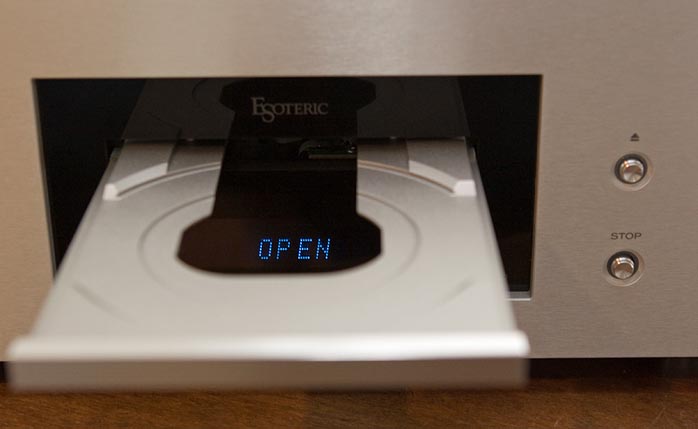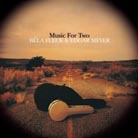|
|
|
|
|
|
This review page is supported in part by the sponsor whose ad is displayed above
|
|
 |
|
Turning to the back of the unit, one is greeted by well-organized and generous connectivity options. Obviously at this price, the power cable can and probably should be replaced by a better aftermarket model. Though Esoteric's manual states in no ambiguous terms not to do so, the sonic benefits were obvious. The SA60 liked the Zu Mother with its added clarity and detail retrieval but I am sure that many other brands, perhaps tonally a little denser, would mate very well too. Important to note is that the SA60 did not particularly fancy being plugged into the Monster power conditioner. This resulted in slower pace and a thicker presentation. The SA60 actually did very well being plugged directly into the wall outlet. It is the first component that did not mate well with the Monster conditioner (although I have heard of similar problems with this conditioning unit from other folks). It's a good reminder to always test components both ways if you own a power conditioner.
In the back you'll also find high-quality RCA and XLR connectors for stereo playback (all solidly attached to the enclosure and comfortably spaced to allow for the most imposing locking RCA plugs extant – thank you Esoteric for small favors). I inquired with the Esoteric experts and although not impossible, they do not recommend the simultaneous use of XLR and RCA outputs because the balanced connection is not protected from a short that could occur on the RCA side and both would get damaged (the reverse is not true). I usually like to connect a player to the main amplifier balanced and save the RCA outputs for my headphone amplifier but to respect the designers' desire, I tapped the signal for my headphone amplifier from the McIntosh's tape loop in this case rather than the player directly.
A third area in the back of the SA60 gives access to the 5.1 multi-channel RCA connections (no XLR there), which I did not use since I do not own a setup capable of taking advantage. Finally a digital section sports the coaxial and optical digital outputs as well as the word clock input should you activate this option. More unusual on a digital player is the presence of a signal (not electrical or earth) ground which can be connected to the ground of your preamplifier to presumably address potential noise issues although the manual once again gives no information. My one disappointment was the absence of a digital input to allow owners of satellite radios or music servers to take advantage of the SA60's high-quality DAC. At this price I would expect to find this function systematically as is the case for Accuphase players.
|
|
 |
|
Until the arrival of the SA60, I had considered my similarly priced Accuphase DP55 to be a reference in build quality and user-focused interface but the SA60, despite one or two minor quibbles, managed to challenge this supremacy. If Esoteric eventually designs a more detailed and useful manual which does not assume that the reader was intimately involved in the conception of the player, they will hit a home run on how much perceived value can be packed into $4600. Of course this does not assume how well the player sounds but when I spend this level of cash, I actually expect the gear to feel and look every penny worth. The SA60 does just that and far more.
To report on how the SA60 sounds, I could easily jump to the conclusion and concur with all previous reviews that this is indeed a fine machine. Alas, that would be missing the critical learning steps to get there. While the SA60 can certainly sound excellent, it will not deliver the goods unless all the moons line up favorably. As we'll see, this can be a long and somewhat arduous process at times.
To wit, after the first month of listening, I was ready to throw in the towel and concede that the SA60 was just not made for me and my system. The sound was extremely clean and noise free but microdynamics were glossed over and attacks were excessively rounded over. All in all, the SA60 was very solemn and at times heavy and pompous - boringly uneventful in other words. The results did vary a bit between CD and SACD but not sufficiently so to blame it on one medium. During that first month of burning in, headphone listening did not bring much of an improvement as it does at times so I would listen to the SA60 for review purposes and go back to the Musical Fidelity A5 for enjoyment. I was getting ready to call it quits when one very early Saturday morning, sleep elusive, I decided to give the SA60 one last chance. Instead of having the headphone amplifier run off the tape loop of the McIntosh, I unplugged the balanced connections and tapped the signal directly from the SA60's RCAs.
|
|
|
I cued up Vivaldi's Stabat Mater with Andreas Scholl [Harmonia Mundi SACD 801571] and was instantly rewarded by one of the best presentations of this disc I have ever heard. I checked if I had not by mistake plugged the A5 back in. It really was the SA60 giving a perfect sense of flow and timing. Scholl's voice had a fascinating level of intimacy and transients were extremely well articulated with their own presence and existence. I was overwhelmed by the feeling of just "right", no excess speed or forced attacks but no lack of dynamics either, just a perfectly timed flow of music by a master counter-tenor. I was so taken that I actually played the disc twice in a row that morning. The second time the overall performance remained as captivating, with Scholl's timbre and perfect articulation finally feeling right for lack of a better word to describe timbre and timing coming together for a lifelike rendition.
|
|
|
 |
|
Convinced that some magic of ultra-prolonged burn-in had finally struck, I reconnected the player to the main system and hit play for the third time on the same SACD. Unfortunately I heard the usual slowing down with its uncertain attacks, nothing like what I had heard two hours prior over the headphones. Not to bore you with all the experiments that followed, I eventually narrowed it down to the balanced connection between SA60 and McIntosh. Any time I used the XLRs, music lost its balance. Anytime I used the single-ended connections to the McIntosh, the A5 amplifier or the Xcan headphone amplifier, timing precision returned, images snapped back into place, attacks regained sharpness and transients lost their fuzziness. Although I've never had this problem before, I can't exclude that the McIntosh may be at least partially responsible for the problem.
If you have read Srajan's review of the X-03, you'll remember that he came to the exact opposite conclusion, clearly preferring balanced operation with this player. Although no expert on the matter, the explanation I would venture is that the X03 is a truly differential design throughout whereas the SA60 is not - and neither is my McIntosh amplifier for that matter. To use the SA60 and MA2275 with balanced interconnects, the signal has to go through two additional active devices, one phase splitter in the SA60, another address in the amplifier to patch it back together. I suspect that combination to be the source of what I heard. On the X-03, it is the balanced signal path that is the purer of the two. I do not know what preamp Srajan used but if it was balanced, it would be consistent with explaining the different results.
To put this matter to rest, I once more wrote to the Esoteric experts to share my findings and a short reply came back that I reproduce below: "The founder as well as the other "golden ears" in Japan also prefer listening to Esoteric products using unbalanced connections. The balanced potentially is quieter but there are characteristics, similar to what you are hearing, that make the unbalanced connections preferred."
|
|
 |
|
I guess this settles the discussion for now. At the very least, it comforts me about not going deaf or crazy. I would strongly encourage people to use the SA60 unbalanced - with the exception perhaps of very edgy and overly detailed systems where the reduced noise and pace of the balanced operation would be more beneficial and the timing imprecision might not be as detrimental (although that would remain to be heard). For the remainder of this review, I focused exclusively on the SA60 connected unbalanced into either the MA2275 or A5 integrated for best results (and not by a small margin).
When it comes to CD playback, a few things stand out in the SA60's performance as compared to the A5 CD player which serves as my main reference. On the positive side, the SA60, even unbalanced, is far quieter than the A5. Not that the Musical Fidelity sounds noisy at all but by comparison, notes emerge from a quieter background with the SA60 and are therefore easier to follow. The final instants of decays linger around just a little longer. If you combine this with a reduced transient emphasis from the Esoteric, you'll have a relatively good idea of the main difference between the dynamic presentations of these two players. To force the trait, the A5 is more of a typical British machine with an enhanced sense of pace and rhythm at the expense of the last breath of note decay (but not at the expense of tone, which is rarer among British CD players); and the SA60 takes a more even approach to timing with clear and sharp attacks not as marked as the A5, and longer richer decays.
Both players portray a very wide soundstage but the SA60 again takes the lead by not only offering a broad window on the music but also a deeper and more clearly layered presentation of orchestras. The A5 always sounds more two-dimensional by comparison. This sense of space combined with the absence of noise make musical lines and instruments easier to follow with the Esoteric. But it does not mean that the SA60 concentrates analytically on individual instruments over the musical phrase. The SA60 is a big-picture player, not a binocular focusing on details. Still, the big picture suddenly got more holographic. Instead of cramming all the music into one place, it gave it more space to breathe and fully expand. The wide and narrow settings of the FIR algorithm will influence how much of this space the player will convey. Although not dramatic, the changes are relatively easy to detect (at least over earphones). As its name suggests, wide actually preserves small signals and ambient cues better, letting decays fully go on forever. Narrow shortens decays, reverberations and ambient cues in favor of being a little more dynamic and punchy.
|
|
 |
|
|
To me the most endearing quality of the SA60 with regard to CD reproduction is its ability to almost completely banish digital glare and the midrange harshness I associate with the RedBook standard. In my review of the SQ12, I noted how the Musical Fidelity player was not entirely free of this flaw, with the filter-less SQ12 doing a better job of avoiding digital nasties. Unquestionably, the SA60 goes even further in its ability to remove stiffness, add flow, space and eradicate midrange aggression.
It is important though to qualify this last comment because the SA60 offers three different upsampling settings for CD playback that behave quite differently from this standpoint. I found the FIR setting to be the most 'CD-like' sounding, with a significant portion of harshness remaining. Extension and bass weight are excellent but at the costly expense of retaining a lot of audible digital artifacts. FIR + RDOT, taking upsampling to a higher frequency, is actually quite interesting. It provides a slightly more refined midrange than FIR alone and packs more weight on top and bottom than PCM-to-DSD upsampling (unlike what is indicated in the brochure, I did not find FIR+RDOT to limit top and bottom extension whatever, quite the contrary actually). This setting was great through headphones, especially the somewhat reserved AKG K701. It offered a far more efficient mechanism to widen headspace than any cross-feed implementation (whether software or hardware) I have heard thus far.
I know most headphone fans usually look for the ultimate level of detail retrieval which the SA60 won't provide. Still, if you are willing to give up some of the less musically relevant information, the Esoteric is quite impressive through headphones, with a faultless sense of flow and timing. To my mind, the true winning setting on most discs was the ability to up-convert CD to DSD for decoding by the Cirrus chip just as it would decode data coming off SACD. This algorithm yielded the overall most convincing sound quality, almost restoring the upper midrange and treble to their analog-like beauty (perhaps not quite but closer than anything I have ever heard from a CD). The price to pay is a reduction in presence, dynamic and extension.
|
|
|
|
As I am typing this review, I am listening to a medley of Callas recordings from the 50s and 60s [EMI 7243 5 56461] which are an incredible testimony to her talent and an equally strong testimony of the very poor quality of digital transfers made in the early to mid 90s where a lot of her unique warm harmonic colorations are gone and replaced with a plainer drier timbre. The SA60 can't restore those CDs to LP sound but for the first time in years, I can actually listen to this disc and fully enjoy Callas' incredible way with intonation and subtle nuances. "La Mamma Morta" has always been an ear-bleeding track on any gear but the SA60, without taking the biting notes away, gave them a slightly gentler nuance. By contrast, when singing "Dalila", Callas can sound almost like a mezzo, showing the full richness of her deeper voice. On that track, the SA60 excelled at rendering her voice's harmonic complexity without taking much away. It is actually nice to have those questionable transfers come back to life even if through technical artifice. |
|
|
 |
|
There are two areas where I do not think the SA60 quite matches the A5 or Accuphase DP55 players. The first would be tone density or more exactly, its ability to compensate for recordings lacking a rich tonal palette; the second bass weight and tautness. The tonal bleaching is especially obvious on massed strings which can sound thinner than through the A5. I first noticed it on another one of my older CDs, a pressing of Karajan directing Haydn's Parisian Symphonies released by Deutsch Grammophon (already not famous for their tone density on LP, DG's early digital recordings such as this DG 419 741-2 are starved for body and soul). The SA60 made the string section of the Berliner Philharmoniker sound like it was composed of one silvery violin only, violas and celli somehow forgotten in a closet. The A5 managed to conjure up an overall more credible tonal balance for the orchestra from the same rarefied information on the disc.
|
|
|
|
 |
|
 |
|
I also heard a similar silvery sheen on a few recordings of deep male voices like Leonard Cohen's. I am sure he would be flattered to hear himself a few pounds lighter and a few years younger as the Esoteric had it but that's not really how other CD players render his gravelly voice.
|
|
|
Although I don't really like doing so, I was able to partially overcome these minor tonal deviations by switching from the Zu Varial interconnects to the slightly warmer Consonance Billies. The sense of space was slightly reduced but strings and sopranos gained a touch |
|
more weight and presence. Although this overall tonal balance sounded more satisfactory to me, I never managed to match the darker, denser and overall more intense tones of the A5's tube output stage on Cohen's voice nor could the SA60 quite match the organic richness of the Accuphase sound either, at times sounding drier than I felt desirable. Overall the SA60 will probably do better with amplifiers and speakers already tonally saturated. I wish I had a pair of Zu or WLM speakers handy as I suspect the association would be truly special but did not get a chance to test this hypothesis.
|
|
| The relative lack of bass weight and tautness was absolutely not obvious on most classical music. I got my first hint of it on Renaud Garcia-Fons' Legend but it was not until I cued up the brilliant Music for Two by Bela Fleck and Edgar Meyer [Sony SK92106] that I really understood the true magnitude of difference between SA60 and A5. Music for Two is a fantastically clever dialog between banjo or guitar played by Bela Fleck and Meyer's straight bass or piano. The acidic plucked tones of the banjo make for a very complementary counterpoint to the deep, sustained and raucous voice of the bass. Unfortunately on the SA60, Meyer's bass lost a lot of its coherence. It sounded boomy and lacking in detail. I probably would have missed the less than stellar performance had I not heard the same disc on a great system a week before (a combination of SQ12 CD-player, Hyperion 968 speakers and Granite |
|
|
|
 |
|
| Audio monos) to known how much better the bass should have sounded. I switched the disc to the A5 and the presentation of the upright bass snapped back in place, gaining weight, extension and texture. I was able to partially compensate for this issue by changing the upsampling scheme to FIR+RDOT but I was never quite able to duplicate the excellent bass presentation of the A5 with the SA60. This disc is probably extreme in its amount of high-quality information and detail below 40Hz. Unless you listen to a lot of cavernous low frequencies, you probably will not notice the imperfect control down low - at least I did not on any other disc. |
|
|
 |
 |
|
|
|
 |
|
|
|
|
|
|
|
|
|
|
|
|
|
|
|